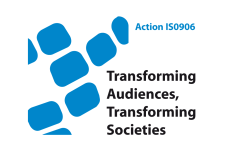- About the Action
- Events
- PhD workshop - Ljubljana 2014
- Action Open Conference - Ljubljana 2014
- New Media and Participation conference - Istanbul 2013
- Belgrade meeting 2013
- Media literacy research and policy - Brussels 2013
- ICA Pre-Conference 2013
- Tampere meeting 2013
- Budapest workshop 2012
- Milan meeting 2012
- Brussels PhD workshop 2012
- Brussels Action workshop 2012
- London meeting 2011
- Zagreb Conference 2011
- Lisbon meeting 2010
- Affiliated events
- WG 1
- WG 2
- WG 3
- WG 4
- Cross-WG
- Output
Objectives
Primary objective
The main objective of the Action will be to advance state-of-the-art knowledge of the key transformations of European audiences within a changing media and communication environment, identifying their interrelationships with the social, cultural and political areas of European societies.
Secondary objectives
1. Revitalising the audience research agenda
The mainstream agenda of audience research fails to embrace a number of audience transformations. Vital issues need to be addressed that take into consideration the latest social and technological innovations.
2. Developing innovative approaches to audiences
A related objective of the Action is to revise the existing theoretical and methodological approaches to audiences. Yet one should not throw out the baby with the bath water. This Action will capitalise on existing theories, methods and findings, extending valuable theoretical insights, readapting tried-and-tested methods, and recognising historical continuities as well as changes.
3. Transcending established boundaries in the field
Developing new approaches to audiences requires from researchers that they cross disciplines (e.g., between the social science tradition and the critical/cultural tradition) and long-established boundaries in the field (e.g. between ‘old media’ and ‘new media’; between mass communication and group communication; between content/production and audience/reception).
4. Promoting new empirical research on audiences
Claims about contemporary audience transformations are often made on the basis of observed media and technological developments, without taking into careful consideration actual audience practices. This rather speculative, often deterministic approach will be countered by this Action, for it aims to build empirically-informed, critically framed knowledge of audience transformations.
5. Scoping the new media and communication environment
Audience practices are shaped at the interface of media and technologies on the one hand, and social, cultural, political and ideological processes on the other. Participants in the Action will therefore coordinate their research efforts in order to build a detailed and up to date picture of the contemporary European media and communication environment.
6. Networking audience researchers and building capacity
Finally, the Action aims at establishing a long-term culture of cooperation among European audience researchers, which includes linking early-stage researchers and senior researchers.

